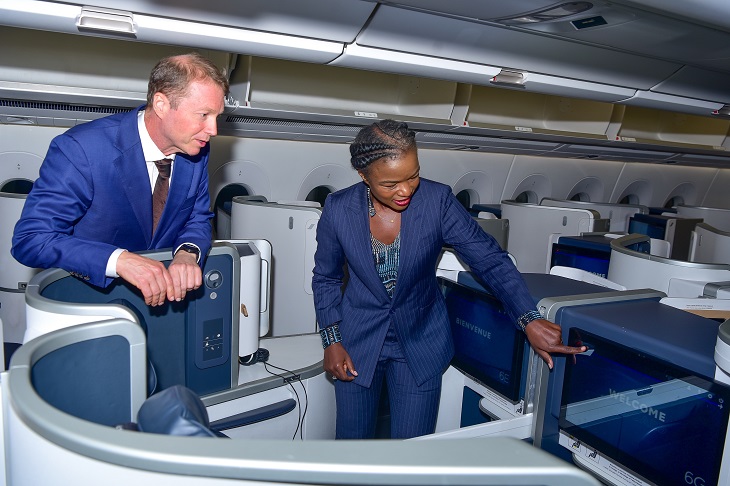Air France has introduced the Airbus A350-900 on its Paris–Nairobi route, reinforcing its strategic commitment to increase seat capacity in response to growing demand for both business and leisure travel. The new aircraft replaces the Boeing 787- 9, which has hitherto been flying the route, with a 16% increase in seat capacity.
Over the past three years, Air France has recorded a steady rise in passenger numbers on this route, in response to which it welcomed the Airbus A350-900 on Monday at Nairobi’s Jomo Kenyatta International Airport, marking the aircraft’s maiden voyage to the Kenyan capital. This development signals a significant expansion of Air France’s footprint in East Africa and forms part of the carrier’s broader fleet modernization strategy.
“This aircraft brings about 16% more seats to Kenya, and this implies that we can accommodate further growth in the Kenyan market against increasing demand for Paris and Europe as travel destinations,” said Joris Holtus, Air France-KLM’s General Manager for East and Southern Africa, Nigeria, and Ghana.
The Airbus A350-900 offers enhanced passenger comfort, greater capacity, and consumes less fuel than equivalent-sized previous-generation aircraft. The introduction of the new aircraft underscores Air France’s intention to provide a superior travel experience while meeting the increasing market demand.
“This aircraft perfectly aligns with two pillars of our strategy. The first is premiumization—that is, bringing premium products to our customers. The Airbus A350 symbolizes this by introducing premium business, premium economy, and economy classes. The second pillar of our strategy is decarbonization, and the Airbus A350 consumes up to 25% less fuel than an equivalent-sized previous-generation aircraft,” said Holtus.
The Airbus A350’s unveiling coincides with renewed momentum from the Air France-KLM Africa office in Nairobi, which has, since its inception in 2023, been instrumental in driving regional growth and reconnecting with East African travelers. As the airline deepens its commitment to the region, the deployment of aeroplanes marks both a technological upgrade and a strategic milestone in Air France’s ongoing investment. Currently, about 25% of Air France’s fleet comprises next-generation aircraft, against plans to increase this to 50% by 2025 and 80% by 2030. And with just over 38 Airbus A350s currently in its fleet, Air France’s decision to assign one to Nairobi, a route now served with three daily flights, highlights the city’s rising status as a key African hub.
“We are enhancing passenger comfort and operational efficiency, while laying down a vital link that supports the region’s growing demand for world-class air travel. This move also reflects our long-term commitment to the African market and our belief in Nairobi’s pivotal role in shaping the next chapter of aviation across the continent,” said Hildabeta Amiani, Air France-KLM’s Country Sales Manager, Kenya.
The global airline industry is poised to carry a record 4.99 billion[1] passengers by the end of this year, according to new projections by the International Air Transport Association (IATA), signalling a full recovery and renewed growth five years after the coronavirus pandemic brought air travel to a halt.
The expected figure marks a 4.4 percent increase over 2024 and 9.4% over pre-pandemic levels. The growth also comes despite a broader economic slowdown. While global GDP growth is projected to fall from 3.3 percent in 2024 to 2.5 percent in 2025[2], airlines are on course to profitability, driven largely by operational efficiencies and a surge in passenger demand. Load factors—an industry measure of seat occupancy—are expected to reach an all-time high of 84 percent, even as aircraft manufacturing continues to be hampered by supply chain constraints.
The momentum is especially strong in Africa, where revenue per kilometer rose by 13.2 percent last year[3]. The continent has seen a resurgence in business and tourism travel, as markets rebound from the long tail of the pandemic.
Meanwhile, the introduction of the A350-900, one of the most fuel-efficient long-haul aircraft in operation, reaffirms Air France’s dual focus of meeting growing passenger demand while cutting its environmental footprint. The A350-900, which carries up to 44%[4] more passengers than its predecessor (A330-200), offers significant environmental gains, consuming 25 percent less fuel, translating to just 2.5 liters per passenger per 100 kilometers[5]. This is thanks to an ultralight design that includes 53 percent composite materials and 14 percent titanium[6]. Its aerodynamic profile also reduces noise by 40 percent[7], helping ease pressure on airport-adjacent communities.
Inside, the aircraft is designed with passenger comfort in mind. It features a reconfigured cabin layout across all classes, 30 percent larger windows, enhanced air pressure systems for improved cabin ambiance, and adaptive lighting to reduce jet lag. It also boasts one of the quietest twin-aisle cabins in the sky.
Across the world, Air France’s broader modernization strategy aims for more than half of its fleet to consist of new-generation aircraft by the end of 2025, a shift the airline describes as essential to meeting international climate targets. Other sustainability efforts include eco-piloting techniques, onboard recycling, and the phase-out of single-use plastics.
Related Content: Air France Appoints Joris Holtus As General Manager For East And Southern Africa, Nigeria And Ghana

